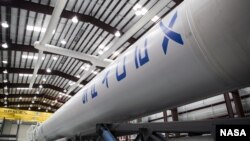The first private firm to successfully launch a reusable cargo space capsule, Space X, says its reusable booster rocket -- Falcon 9 -- will dramatically lower the cost of launching space vehicles. NASA and the French space agency CNES, however, say it may not be a good idea.
Speaking at a recent space conference in Paris, officials from NASA and CNES said their experience in reusing booster rockets shows technical and economic obstacles are too costly.
NASA Deputy Associate Administrator Dan Dumbacher said his agency found that the space shuttle’s main engines required so much refurbishment after flight that it simply was not worth trying.
Cristophe Bonnal, an official with CNES, added that major safety issues prevented reuse of the Ariane 5 rocket engines.
In April, Space X successfully landed its Falcon 9 booster rocket in the Atlantic but it eventually was lost due to a strong storm. The company now plans another attempt to soft land the rocket in water and later even on dry ground.
Space X says refurbishing the rocket after landing in water may take two months, while doing so after landing on ground may take only a day.
Speaking at a recent space conference in Paris, officials from NASA and CNES said their experience in reusing booster rockets shows technical and economic obstacles are too costly.
NASA Deputy Associate Administrator Dan Dumbacher said his agency found that the space shuttle’s main engines required so much refurbishment after flight that it simply was not worth trying.
Cristophe Bonnal, an official with CNES, added that major safety issues prevented reuse of the Ariane 5 rocket engines.
In April, Space X successfully landed its Falcon 9 booster rocket in the Atlantic but it eventually was lost due to a strong storm. The company now plans another attempt to soft land the rocket in water and later even on dry ground.
Space X says refurbishing the rocket after landing in water may take two months, while doing so after landing on ground may take only a day.








